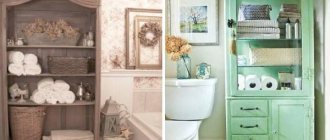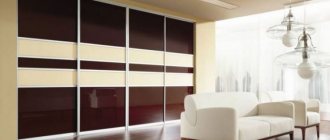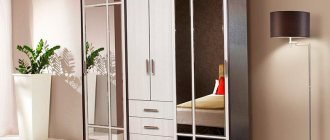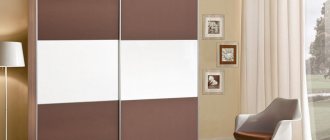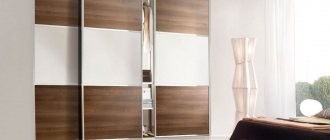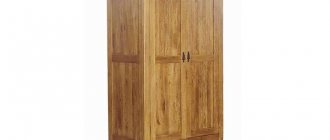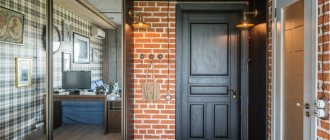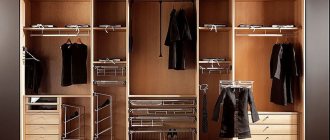Types of sliding wardrobe door opening mechanisms
A special feature of the wardrobe is the way the door opens. The sash does not swing open, but slides along the facade. It does not take up space, which allows you to place a large wardrobe in a small room and install other furniture next to it - this will not interfere with the opening of the doors.
There are 2 mechanisms that provide this method of opening:
- roller - the door leaf moves along the lower and upper guides. Most of the load falls on the lower rollers, so they are much more massive. The advantages of the system: the sash does not warp when moving even with a large amplitude, the weight of the material does not matter, the service life is maximum. Disadvantage: the bottom guide creates a kind of threshold. The guides accumulate dust, so you need to clean the cabinet more often;
- suspended - the leaf moves only along the upper guide; the door leaf at the bottom does not touch the floor. Pros: the sash moves easier. Cons: door leaf weight limit – 80 kg.
Mechanisms are also distinguished by material:
- steel - strong, durable, very reliable. Disadvantages: possible corrosion and weight. To protect the steel profile and opening mechanism, the metal is coated with waterproof enamel and painted. Expensive models use stainless steel;
- aluminum - do not corrode. Much lighter, durable, varied in design. Aluminum itself is attractive due to its color and shine. You can additionally decorate the profile – not the guides – by covering them with PVC film or painting them. The disadvantage is lower mechanical strength compared to steel. If the door leaf is made of a mirror and is large in size, it is better to use a steel profile.
If the weight of the door leaf and the characteristics of the fittings do not match, the door quickly becomes “loose” and may come out of the grooves when opened.
Suitable Models
When choosing sliding wardrobes in a classic style, you should decide which model will fit best into the interior. They can be shaped or rectangular in shape. As for the design, there are cabinet, corner, built-in, modular and semi-built-in types of cabinets. Each model has its own characteristics.
| Cabinet design | Characteristic |
| Hull | This option can take up an entire wall in the room. This is an independent piece of furniture, consisting of an upper and lower wall, sides, doors and internal shelves, drawers |
| Built-in | This model often does not have sidewalls, since their function is “taken over” by the main walls of the room. The furniture is built into a niche, which allows you to fully use the space of the room. This option is preferable when arranging small apartments. In order for the structure to occupy the entire volume of the niche, it is made to order |
| Semi-built | This model has sidewalls. Most often, the cabinet is installed in the corner of the room or along the wall. Internal shelves are fixed directly on the main walls of the room, so there is no risk that the structure will fall. With this type of fastening it is not easy to move furniture |
| Modular | Sliding wardrobes of this type are made of several separate parts, which are folded into one structure. The location of the parts can be changed. Additional components are often a mezzanine, a corner part, a pencil case with shelves |
| Corner | This design allows you to use all the usable space in the room, so it is ideal for small spaces |
Purpose of profiles for sliding wardrobes, overview of varieties
If rectangular models are more familiar to users, then curly ones are less common. They can be triangular, pentagonal, trapezoidal or radius. The latter option is most often designer and made to order.
Hull
Built-in
Semi-built
Modular
Angular
Photos in the interior
<
>
A white wardrobe can be combined with any shades, matches any style, and serves as a means of zoning. Color visually enlarges the room. However, such a cabinet is the largest detail of the interior, so the furnishings of the room are selected taking into account its design, and not vice versa.
Manufacturing materials
The most suitable material for making classic sliding wardrobes is natural wood. It is durable, environmentally friendly and can be repaired in case of breakdown. However, such raw materials are expensive, so manufacturers prefer to use substitutes:
- MDF. Plates are more often used to make the back wall of the product and the bottom of drawers. They do not withstand too high loads, so they are rarely used for main body parts.
- Chipboard. Chipboard is widely used in furniture production. It is sufficiently durable and has a long service life, but contains formaldehyde resins, so it is better not to install such a cabinet in a children's room. The material is also contraindicated for allergy sufferers.
- Laminated chipboard. The material imitates wood texture, so it has an attractive appearance. The slabs are difficult to process.
- Veneered wood. This material is cheaper than natural material and is used for the production of side walls and furniture facades.
Features of sandblasting patterns on the wardrobe mirror, photo of decor
As for wardrobe doors, mirrored or glass surfaces, decorative acrylic, rattan or bamboo are suitable for classics. The use of such materials will make the piece of furniture exclusive.
A facade made of bamboo or rattan is recommended for rooms with high humidity.
Array
MDF
laminated chipboard
Veneer
General rules for choosing a wardrobe
Choose a model taking into account many factors:
- dimensions - minimum cabinet depth - 45 cm, minimum door width - 50 cm. Furniture of such dimensions requires some space. The maximum depth and width are limited only by convenience: for example, moving a sash with a width of more than 1 m is simply inconvenient;
- facade shape - radius ones are the most impressive, but they also cost the most. Ordinary smooth sashes are cheaper, and their design can be no less interesting;
- material – budget models are made from chipboard and MDF. Solid wood is much more expensive and heavier. Mirror and glass doors are more popular than wood;
- system - suspended structures are more convenient and look more impressive. However, the option with 2 guides is more durable;
- filling - the simplest model includes a clothes rail, a number of shelves and drawers. Pantographs, trouser drawers, pull-out laundry baskets, etc. appear in tall, spacious cabinets;
- design – the design of the cabinet should match the interior.
Facade design options
The facade is the “face” of the wardrobe, so it should look beautiful and fit into the classic style. Despite the fact that design requires compliance with the rules of rigor and conciseness, decorating furniture is not prohibited. For this purpose the following elements can be used:
- Mirror. A cabinet with such a front is installed in a small room or corridor, as it can visually increase the space. Today the mirror is covered with shockproof film. Even if the material is damaged, it will not shatter into small pieces.
- Lakobel. It is glass coated with colored varnish.
- Decorative glass. The facade has a pattern made using sandblasting technology. The material remains tinted, so the contents of the cabinet are hidden.
- Facade with photo printing. The sliding wardrobe (the classics do not prohibit the application of drawings to the surface of the product) is decorated with laconic abstract images or natural motifs, openwork edgings.
Fragments of leather, frescoes and stained glass windows, and carved cornices are also used for decoration. To dilute the design, plinths, pilasters, and borders are used. Fragments made of brass and mother-of-pearl would be appropriate.
A classic sliding wardrobe is usually made in warm colors that are not particularly noticeable and do not irritate. The following colors are in demand: alder, oak, walnut, cherry, ivory. You can also choose furniture in sand, beige and gray shades.
Despite all the available variety, white cabinets and furniture in the shade of milky oak remain popular.
Mirror
Decorative glass
Lakobel
Photo printing
In which interior styles is a white sliding wardrobe appropriate?
<
>
The choice is influenced in a certain way by the style, or more precisely, by its inherent color scheme:
- classic - does not allow excess white. A wardrobe made of very light or bleached wood is suitable here;
- Baroque - especially modern modifications accept white furniture decorated with gold ornaments and mirror inserts. Gloss and inlays are allowed;
- For country and Provence, artificially aged facades are preferred. The colors are preferably warm;
- minimalism uses a cold shade, since the latter visually enlarges the space. The color range of high-tech, techno, minimalism is very limited and white prevails in it. Here they combine different shades of white and different textures. Radius models are extremely effective;
- Scandinavian – white color here acts as a universal background. A sliding wardrobe of the same shade is perceived as an architectural element of complex shape;
- in Art Nouveau, the snow-white facade is combined with mirrors, wooden inserts, and brightly painted panels. However, no matter how good the imitation is, it does not harmonize with antique things.
Placement nuances
When arranging a room with a classic design, problems usually do not arise. If the room is small and contains bulky furniture, a sliding wardrobe will fit perfectly. The product has good capacity. To increase space, you can place such furniture in the dressing room. If the room resembles a long rectangle, then it is better to install the cabinet against a short wall.
Popular styles and colors for wardrobes in the living room, examples of placement
If small children live in the house, preference is given to objects with rounded edges. This precaution will help avoid injury. The choice of a wardrobe is influenced by the size of the room, its purpose and design. When placing the product, the following recommendations must be observed:
- In the bedroom, a classic wardrobe is used to store bedding, linen, clothes, books, and other items. If the dimensions of the room allow it, then it is better to choose large, roomy models. It is recommended to place the structure near the bed. This will simplify access to things, since you can get the necessary items directly from the bed. However, such an arrangement of a wardrobe often disrupts normal sleep, so the most optimal placement option is the opposite wall next to the window.
- In the living room, the furniture is a storage area for all kinds of items, souvenirs, and dishes. Corner options are considered in demand, allowing the use of the entire usable area. It is better to place the structure next to the sofa in the relaxation area. If the living room has a square shape, you can install a closet near the entrance.
- The sliding wardrobe looks great in narrow rooms, in particular in the hallway. This product saves space, especially if you install the structure inside a niche. The mirror facade eliminates the need to purchase an additional mirror.
Regardless of whether a classic wardrobe is made from MDF or natural wood, it always looks elegant. This piece of furniture will allow you to store a large number of things without looking bulky. This style does not imply bright colors or luxurious finishes, but such a thing can become a real highlight of the interior.
Bedroom
Living room
Hallway
What interior colors go with a white wardrobe?
Pure white can be combined with your favorite colors. However, the consumer is dealing with shades of white. There are warm and cold:
- warm – milky, creamy, pearl. Warm tones are chosen for rooms with windows facing north, as these shades compensate for cold tones. Warm white goes better with warm tones of other shades: woody, sandy, grassy, orange;
- cold - silver, steel, snow. Cool tones neutralize excess sunlight in southern and western rooms. Combine with cool shades in the interior: blue, smoky gray, marengo, lavender.
The built-in white wardrobe completely merges with the wall and loses its significance in the interior.
